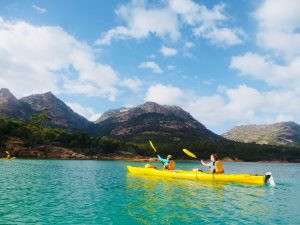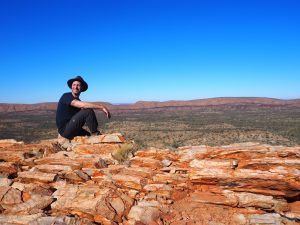Blog home / On the couch with bucket-lister Robin Esrock
Travel author, creator and co-host of the 40-part series World Travels on the Travel Channel and National Geographic International, Robin Esrock, has spent much of the year travelling across Australia to find the best adventures and bucket-list worthy experiences to feature in his version of The Great Australian Bucket List. We sat down with Robin to hear about his time in Australia and why this is not a travel guide book but a guide to why we should travel.

What led you to travel the world, writing, hosting travel television shows, inspiring people to discover the world? When I was 30 years old, I was run down by a car on my way to work. A small brush with death, in my case it was a broken kneecap, was just enough to make me really re-evaluate what I wanted to achieve in life. I didn't even have a bucket list back then, but the idea of just travelling for a long time and looking for adventure and finding myself was appealing and I embraced enthusiastically. I took a $20,000 insurance settlement and quit my job, sold my stuff and I went out there. I never intended to be a travel writer, but I started what we would call a blog today. In 2005, travel blogs were just starting. And it turned out I had a real knack for it and I really enjoyed it. I loved sharing my adventures, recording and picturing them. Then I started getting into newspapers, magazines and then television. And that was 13 years and a hundred countries ago.

Australians are such fanatical travellers and there's so many parallels between Canada and Australia. The Great Canadian Bucket List resonated very well with the Canadians who don't quite realise how good they have it in their own backyard. Canadians seem to look to the USA and Europe before they think about travelling in their own province or country. Australia, when I started looking into it, seemed to have the same issue. Australians are crazy travellers, but not necessarily crazy travellers in their own country. When my publisher approached me about compiling an Australian bucket list, I thought, okay, I think that my voice, my approach and the way of looking for these unique experiences will appeal to Australians. I've only ever kind of touched the surface of the country, so there's an opportunity for me to get to know Australia really well. It is quite an easy country to take on with no language barriers, amazing the food and decent roads.
What was it that surprised you about Australia? Even though I knew the distances were going to be great, they were even greater than I expected. I was surprised at just how uniformly excellent the food was across the whole country. Certainly in Canada we get a lot of North American stuff coming in that's nowhere near the quality. The food here is just outrageous, from the coffee in Melbourne to the fruit in Western Australia. I was surprised that many local people don't quite realise how unique many of the experiences are. Many people haven't been to the Northern Territory's Red Centre and the Top End or haven't been to Western Australia from the eastern seaboard or vice versa. I would've figured, Australia being isolated, Australians would've actually travelled a little bit more than they have. They can tell me all about their adventures in Europe, Scandinavia and Whistler, but they haven't been outside of their state or territory. Even today I was having a conversation with people and they just haven't been around the country.

A lot of people look to travel abroad, not in their backyard. This book will inspire Australians to experience new adventures here in Australia. What experiences have been your favourite ones and most challenging here in Australia? I think my immediate highlights were the Larapinta Trail in the Northern Territory. It was also because it was challenging as well, because I'm not a big hiker. At the tail end of travelling Australia, I hadn't done a lot of exercise and I was like, oh, I'm in no shape to do this. But it was once in a lifetime, a one of a kind, bucket list experience. The landscape, the physical challenge of it, the local people and the indigenous culture. I think that's also something that really surprised me, was just how fascinating the Indigenous culture is in this country. Other things that I really loved were sleeping on the Great Barrier Reef, reef sleeping is actually sleeping on a pontoon on the outer Barrier Reef and it was amazing. The Ghan train service between Adelaide, Alice Springs and Darwin was awesome as was swimming with bluefin tuna in South Australia. Meeting the Prince of Hutt River, an independent self-proclaimed sovereign state in Western Australia was fascinating. I had no idea there's a NASA deep space communication centre in Canberra and you can visit and interact with staff, something we can't do in the US. Everything was so much more accessible than what I expected it to be. A highlight for me was what turned out to be my favorite state of Tasmania. It was cooler, more beautiful, more rugged, less trafficked. My favorite thing about my experience there was that I got to actually travel with my family. As difficult as it was to travel with two young kids, it was really rewarding as well.

You ventured on the multi-activity Cycle Kayak and Walk Tasmania trip - named National Geographic Traveller's 50 Tours of a lifetime. What were the highlights of that particular trip? The East Coast of Tasmania is just so pretty and what I love about this itinerary is it just condenses the best parts. Tasmania represents some of the greatest beauty in the country and this itinerary is like the best of the greatest hits. I'm not a cyclist at all, again, I didn't think I was in any physical shape to take it on, but there were other people in the same condition as me and of all ages. Adventurers looking to kind of get out of their comfort zone, they'll discover and see so much more when cycling, walking and kayaking than on a tour bus or in a car. I loved everything from the kayaking and exploring Maria Island, one of the most amazing spots in the country. It's no big deal that you're tripping over wombats. It's just fantastic and you're so well looked after. On both The
Cycle, Kayak and Walk Tasmania and
Classic Larapinta Trek In Comfort, I loved travelling with like-minded people. I kept expecting there to be some sort of conflict, because I'm traveling with 15 other people in a pretty physically demanding environment, but everybody gels on together really well. Having the camaraderie is one of the best things about it.
In the book you state, "walking the Larapinta Trail on the Classic Larapinta Trek In Comfort is a bucket list experience at its peak and a once in a lifetime opportunity." What makes this trip so special? You're going to look at a landscape you won't see anywhere else in the world. You're going to travel on a land and learn about an indigenous culture that you won't experience anywhere else in the world. The fact that there' are indigenous encounters, where we learned about bush tucker is a fantastic experience. The cultural interaction in Standley Chasm - it left everybody completely blown out of the water and the stars in that part of the world are just like wow! You can't even imagine there are so many stars in the sky. The food was incredible and again, the camaraderie! You're with people who you've just met and you're thrown into this journey together. It's so much more than just going on a hike. It creates an adventure that you can't just dismiss and go, oh that was a holiday. It's not a holiday, it's peak living, it's that peak bucket list, it's the stuff that you remember for the rest of your life. I did it and I'll never forget that experience.

Any tips for traveller's embarking on a trek on the Larapinta Trail in the Northern Territory? I would definitely recommend bringing walking poles and gators. As it is such a temperature variable, it can go hot, cold, or in between so have layers, very thin layers. I brought a bottle of Tabasco, which is always a good thing to travel with, it's always worth its weight in gold. What was hilarious was the day before the walk at the briefing we were advised we can actually have alcohol on this trip because we can bring it to the camps. This is the first time I am meeting my fellow walkers and off we go to the local supermarket to fill our shopping carts full of booze, that was fun. Make sure you have well worn hiking books as you definitely don't want to break in any kind of new shoes on this trail.
You have been travelling with your family around Australia for most of the year. What are your tips with traveling with young children? Slow down. I always say, go where I go, but don't do as I do because we went at a very frenetic pace. Kids just kind of need to go a lot slower and things are a lot simpler. I took my daughter on a sailboat to Fraser Island and when we came back I asked her "what was your favorite part of the day?" and she'll says, the ice cream shop when we got home. They are not so impressed by things, they don't have yet a frame of context to see how special things are. But at the same time, they're so enthusiastic and are so easily blown away by things that we get very jaded about. Wildlife encounters just leave them in awe and I wish chicken nuggets and chips wasn't like a complete food group in every restaurant that we went to. Carry snacks and try and keep it healthy and bring sunblock, hats and all the rest of the sun protection. We live in an age now where you can give your kid an iPad and we shouldn't beat ourselves up about it. When you're going on a trip, it's not easy for kids to sit in the car for long drives, so you try and make it as easy as possible and try to create a consistent environment in a very inconsistent lifestyle. We would try and keep a routine of bedtime, a travel cot, favourite blankie, soft toys and try to given them some sense of control. Because everything else is bonkers for them.